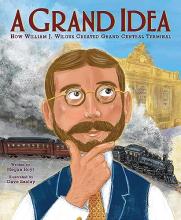Book Reviews

A Grand Idea: How William J. Wilgus Created Grand Central Terminal, by Meghan Hoyt (illustrated by David Szalay)
January 23, 2024
Quill Tree Books (div. of Harper Collins Publishers)
CTB Andrew Aguirre, 800-242-7737 (no email)
Edith G. Tolchin
“It was a magical place. Building such a grand train station without computer-aided design plans… or modern equipment, was difficult.”
At the turn of the twentieth century, New York City was busy with the hustle and bustle of trains, motorcars and smoking engines polluting newly paved streets.
New York City became a hub for curious travelers to see “the big city.” However, trains were not always safe and soon an accident occurred injuring, “or worse,” at least fifty-five passengers. William J. Wilgus, a chief engineer quickly decided to fix these dangers. He designed steel trains and built two train track levels below New York City. The wealthy Vanderbilt family helped fund the project, and many architectural firms vied to participate.
Grand Central Terminal would be huge, both above and below ground. There would be sixty-seven steel train tracks. Grand opening was in 1913. Sightseers ran en masse to visit the restaurants, and later, Wilgus helped create a hospital, tennis court, library and a ski slope. It was a success for many years.
As air travel began to replace rails, some famous New Yorkers, including Jackie Onassis, worked towards a case to save Grand Central—a case which reached the New York City Supreme Court.
After much publicity, Grand Central Terminal was saved, and to this day, tourists visit the outstanding edifice daily.
Author Meghan Hoyt caters to young readers aged four to eight with simple yet thought-provoking sentences such as, “It was a magical place. Building such a grand train station without computer-aided design plans… or modern equipment, was difficult.”
Vibrant, colorful drawings appropriate for the 1900s, created by David Szalay, adeptly describe the obstacles, plans, developments, and pictures of Grand Central Station from idea stage through present time.
Bonus appendices appear at the end of the book including a brief biography of architect William John Wilgus, curious additional facts about the Grand Central Terminal, a “Grand” timeline from 1871 through 1995-1998, and “Sources” used for creation of this masterpiece for budding junior historians.
